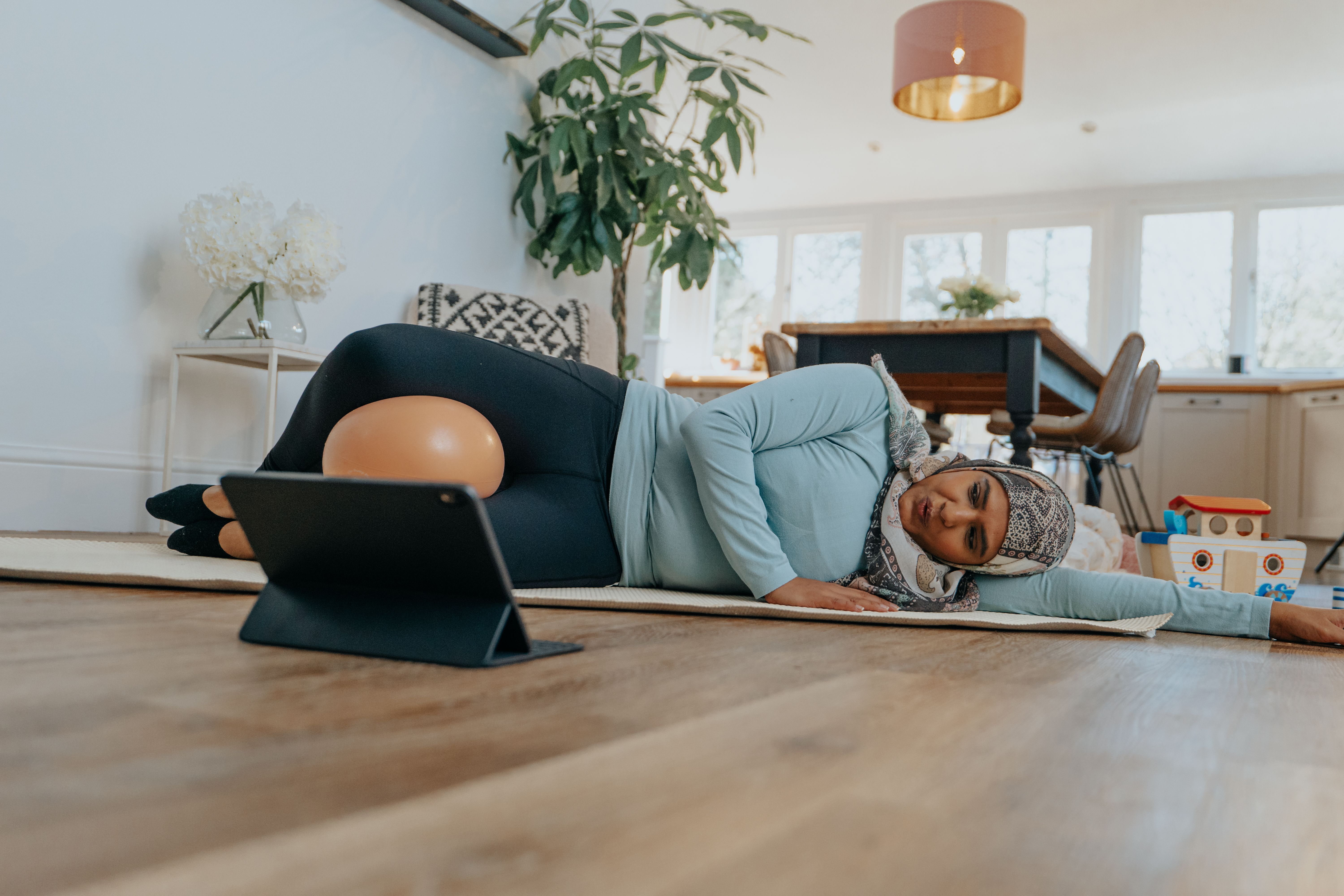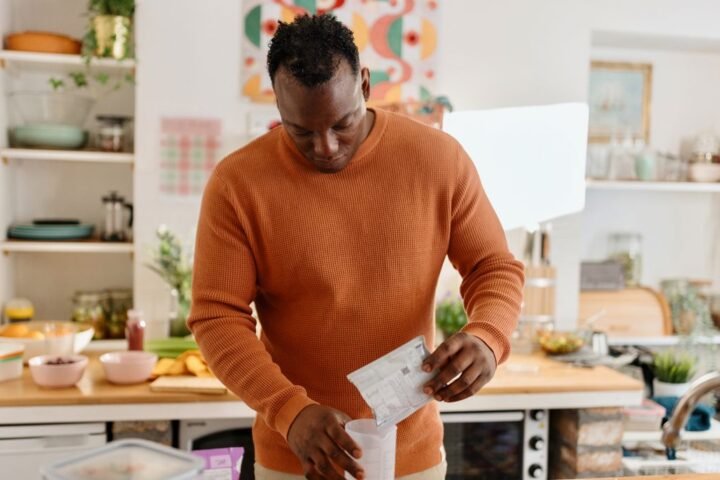I’m usually pretty active with running, cycling and strength training generally featuring in my week. However, pregnancy changed things somewhat. I took it very easy for my first trimester—mostly because I felt nauseous unless I was eating toast.
By my second trimester the nausea had passed and I wanted to do more exercise, but didn’t know where to start. Without guidance from a qualified prenatal fitness expert, it’s hard to know what’s safe in pregnancy and what could potentially injure you (simply coughing while lying in the wrong position would send me into spasms of round ligament pain). I scoured the timetable at my gym but there were no pregnancy-specific fitness classes. I began weekly pregnancy yoga at my favorite yoga studio, started swimming once a week and occasionally doing some very gentle running. But most days I didn’t move much, and I still felt pretty sedentary.
So when I had the opportunity to test and review online fitness program The Bump Plan I was keen to give it a go. Offering a combination of Pilates-style strength training and cardio workouts, the subscription-based fitness platform caters to those trying to conceive, as well as those who are pregnant and postpartum. You can join at any point, even late in your pregnancy or after having your baby.
How Much Does The Bump Plan Cost?
Membership costs £35 per month, with a discount if you pay for six months (£180) or a year (£240) upfront. When you sign up you have the option to buy a £15 starter pack that includes a Pilates ball and resistance band—other than a mat, that’s all the equipment you need for the classes.
What Do You Get With The Bump Plan?
The Bump Plan gives you six workout videos to complete in a week, with the same videos to repeat weekly before you get a new set of videos (these currently change at weeks 12, 18, 24 and 30). Six workouts per week may sound like a lot, but they are all 20 to 30 minutes long, so I found them easy enough to slot into my day, and together they add up to the 150 minutes of moderate-intensity exercise per week recommended for pregnant women (and indeed all adults aged 19-64) by the UK government.
All the videos are created and led by Hollie Grant, an award-winning Pilates instructor and personal trainer, and were recorded while she was pregnant. In each of the videos, she is at more or less the same stage of pregnancy as the viewer. I found this immensely helpful—everything felt all the more achievable and encouraging thanks to a feeling of being in the same boat, plus Grant’s down-to-earth teaching style and her frank discussions of the physical challenges of pregnancy were very welcome.
Weeks 18-24 of the program gave me access to two 20-minute Pilates sessions, three cardio-Pilates sessions and a 10-minute stretching session. Each workout also contains a short pelvic floor exercise session at the end. I know how important it is to do pelvic floor exercises but (confession) I never actually do them unless I’m being told to, so having them scheduled into my workouts was ideal.
There’s also a weekly live class, led by Grant, that you can join as part of the program. It was nice to catch a glimpse of some of the other prenatal mamas following along, and it was also good to be able to connect with Grant before and after the class and ask any pressing questions. These workouts are recorded (minus the chit-chat) and become bonus workouts available alongside your weekly workouts.
The Bump Plan also offers more than just workouts. In the education hub section of the website, subscribers also get access to a library of articles by qualified health experts, as well as video interviews and recorded webinars on topics ranging from pelvic girdle pain and sciatica to hypnobirthing, cesarean sections, and baby and toddler first aid. I found it an informative and helpful place to explore and learn more about issues that are often little discussed—there’s even an expert interview that tackles “the post-birth poo”!
Members can also access weekly live clinics with experts including a women’s health physio and a lactation consultant, where you can ask questions.
What Are The Bump Plan Workouts Like?
By the time I began the program during my 19th week of pregnancy, I was doing a small amount of mostly low-impact exercise. Plus I was dealing with the demands of work and family life, with a six-year-old keeping me on my toes. But, I still felt like I was missing some form of more structured exercise that raised my heart rate, and I felt rather feeble and got tired easily. Usually I felt shattered in the evenings, even when I’d barely left the house.
When I began the workouts, I found them very manageable—they’re not too long and there’s an emphasis on keeping effort levels moderate and not getting too out of breath. The videos I followed had no dynamic movements: all cardio was low impact.
There were a lot of squats though—at my stage in the second trimester the program focuses on strengthening your legs and glutes to help with proper posture and support for your back, as well as preparing you for an active labor. I really felt it in my quads and hamstrings after the first couple of workouts. But when I returned to those same videos in the second week, my muscles coped fine and I had no soreness afterward. By the third week I was progressing as suggested by holding a light pair of dumbbells for many of the exercises.
The six workouts for the week felt well-planned, targeting different areas of the body in the safest possible way. There are lots of modifications on offer for those experiencing symptoms such as pelvic girdle pain, or ways to take it down a notch if you’re getting too out of breath.
I found the live workouts a particularly worthwhile addition. Having got to know Grant through the videos it was motivating to interact with her live and do some different exercises. In the live sessions I attended there were options for more dynamic movement if you wanted it.
I asked Grant why the live classes involved dynamic exercises, while the recorded classes do not. “Version one of the Bump Plan was filmed five years ago while I was pregnant with my daughter and back then the guidance was that you should avoid impact while pregnant,” says Grant. “But since then there has been so much research done and new guidance published. And awareness of the fact that actually impact is fine during pregnancy as long as your pelvic floor is comfortable with it, and you’re comfortable with it. Baby is completely cushioned and safe.”
“I refilmed the Bump Plan while I was pregnant with my son [who is now one year old], and it’s just about to go live in a few weeks,” says Grant. “You’ll get more workouts, they change more regularly and they’re more challenging. I do encourage you to jump and bounce around as long as it’s comfortable for you. And there’s loads of information about pelvic floor strength. Things like pressure management in the core, all sorts of things like that. So if you want to be challenged, you can be.”

Is The Bump Plan Worth It?
Within a week of starting the plan I felt stronger and more energetic. I could go on a long walk without feeling heavy and exhausted by the end, and I could carry my bike up the steep front steps to my house with confidence. Three weeks into the plan (and halfway through my pregnancy) my glutes, legs, core, chest, arms and shoulders feel stronger, and even as my bump seems to expand by the day I feel better equipped for the movements and challenges of daily life. I’m getting fewer back twinges and I’d even say my mood is more stable.
I’ve found that having a schedule of six short workouts a week is really helping me stay more active. It’s a challenge to get them all done but because each one is only 20 or 30 minutes long, fitting one in nearly every day feels achievable, and I don’t beat myself up if I miss a couple of sessions here and there. The workouts themselves feel like they’re making a difference and yet they’re never too taxing.
The videos do get slightly repetitive after a while and I would prefer to have a wider range of videos to choose from or for the videos to change more often, and I’d like the option to include more dynamic moves in the workouts, but these changes are on their way, with the Bump Plan update planned for mid April 2024.
Grant herself is very available and responsive to subscribers, encouraging people to email with questions, or stay and chat at the end of live sessions. There’s also an active closed Facebook group where she’ll respond to comments. With her enthusiasm and openness, it’s like having your own cheering squat rooting for you.
I think it’s absolutely worth paying the monthly subscription, and I’m intending to keep following the program for the rest of my pregnancy and beyond—the postnatal program sounds excellent too, with different videos depending on whether you had a vaginal birth or C-section. Progression to the next phase is entirely dependent on when you feel ready.

There’s a week’s free trial to see if The Bump Plan is right for you before committing. But if you don’t fancy paying a monthly subscription and you’d rather devise your own workouts along the same lines, it’s worth reading Grant’s book, The Bump Plan, (£16.99 / $22.99) published in 2023. It equips you with the knowledge of what kind of exercise is safe and most beneficial at every stage of pregnancy and why, and has examples of suitable workouts.
As always when trying something new, especially when pregnant, it’s important to check with your healthcare professional to be sure that this kind of exercise is safe for you.
Sign up for a free trial of The Bump Plan on the website.







